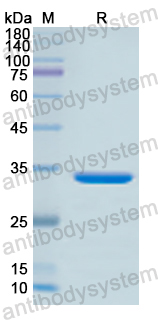Catalog No.
YHE12101
Expression system
E. coli
Species
Homo sapiens (Human)
Protein length
Pro315-Asn456
Predicted molecular weight
18.91 kDa
Nature
Recombinant
Endotoxin level
Please contact with the lab for this information.
Purity
>90% as determined by SDS-PAGE.
Accession
P35527
Applications
ELISA, Immunogen, SDS-PAGE, WB, Bioactivity testing in progress
Form
Lyophilized
Storage buffer
Lyophilized from a solution in PBS pH 7.4, 0.02% NLS, 1mM EDTA, 4% Trehalose, 1% Mannitol.
Reconstitution
Reconstitute in sterile water for a stock solution.
Shipping
In general, proteins are provided as lyophilized powder/frozen liquid. They are shipped out with dry ice/blue ice unless customers require otherwise.
Stability and Storage
Use a manual defrost freezer and avoid repeated freeze thaw cycles. Store at 2 to 8°C for frequent use. Store at -20 to -80°C for twelve months from the date of receipt.
Alternative Names
Cytokeratin-9, K9, Keratin-9, CK-9, KRT9, Keratin, type I cytoskeletal 9
KRT9 is required for GBP5 suppression of human respiratory syncytial virus., PMID:39835811
Proteomic Analysis of Plasma Exosomes Enables the Identification of Lung Cancer in Patients With Chronic Obstructive Pulmonary Disease., PMID:39778061
Mass spectrometric detection of keratins in tear fluid., PMID:39761842
Clinical and Genetic Findings in Patients With Palmoplantar Keratoderma., PMID:39630431
The use of ectopic volar fibroblasts to modify skin identity., PMID:39236183
Lagerstroemia macrocarpa extract inhibits Th2-mediated STAT6 signaling pathway in human keratinocytes., PMID:38354819
Sustained xanthine oxidase inhibitor treat to target urate lowering therapy rewires a tight inflammation serum protein interactome., PMID:38260556
In-depth metaproteomics analysis of tongue coating for gastric cancer: a multicenter diagnostic research study., PMID:38191439
Transcriptional differences between vesicular hand eczema and atopic dermatitis., PMID:37857578
Cohen syndrome coincident with epidermolytic palmoplantar keratoderma caused by novel KRT9 gene mutation: A rare case report., PMID:37690893
Proteomic profiling reveals KRT6C as a probable hereterodimer partner for KRT9: New insights into re-classifying epidermolytic palmoplantar keratoderma (EPPK) and a milder form of pachyonychia congenita (PC-K6c) as a group of genetic cutaneous disorders., PMID:37467889
A computational approach for the identification of key genes and biological pathways of chronic lung diseases: a systems biology approach., PMID:37422662
A novel telomerase activity and microRNA-21 upregulation identified in a family with palmoplantar keratoderma., PMID:37419429
An in-frame 18 bp deletion in linker domain L1 of KRT9 identified in a Japanese patient with epidermolytic palmoplantar keratoderma., PMID:37401035
Salivary annexin A1: A candidate biomarker for periodontitis., PMID:36935103
Allogenic Adipose-Derived Stem Cells in Diabetic Foot Ulcer Treatment: Clinical Effectiveness, Safety, Survival in the Wound Site, and Proteomic Impact., PMID:36674989
Palmoplantar Keratoderma: A Molecular Genetic Analysis of Family Cases., PMID:36076978
A unique skin phenotype resulting from a large heterozygous deletion spanning six keratin genes., PMID:35822506
Integrated proteomics and metabolomics analysis reveals hubs protein and network alterations in myasthenia gravis., PMID:35802752
Nonsense mutations in KRT1 caused recessive epidermolytic palmoplantar keratoderma with knuckle pads., PMID:35490383
Genome-wide identification, characterization, and expression analysis of keratin genes (KRTs) family in yak (Bos grunniens)., PMID:35085710
Protein expression of prognostic genes in primary melanoma and benign nevi., PMID:34757537
Hereditary palmoplantar keratoderma - phenotypes and mutations in 64 patients., PMID:33914963
Cytoskeletal Alteration Is an Early Cellular Response in Pulmonary Epithelium Infected with Aspergillus fumigatus Rather than Scedosporium apiospermum., PMID:33890146
A heterozygous SERPINB7 mutation is a possible modifying factor for epidermolytic palmoplantar keratoderma., PMID:33012634
Proteome Profiling of the Exhaled Breath Condensate after Long-Term Spaceflights., PMID:31547269
Keratin 9 L164P mutation in a Chinese pedigree with epidermolytic palmoplantar keratoderma, cytokeratin analysis, and literature review., PMID:31525823
Functional study of 14-3-3 protein epsilon (YWHAE) in keratinocytes: microarray integrating bioinformatics approaches., PMID:31244373
Altered keratinocyte differentiation is an early driver of keratin mutation-based palmoplantar keratoderma., PMID:31220272
Novel mutation in the DSG1 gene causes autosomal-dominant striate palmoplantar keratoderma in a large Syrian family., PMID:31192455
Exome sequencing identifies a KRT9 pathogenic variant in a Chinese pedigree with epidermolytic palmoplantar keratoderma., PMID:31074163
Pathophysiology of pachyonychia congenita-associated palmoplantar keratoderma: new insights into skin epithelial homeostasis and avenues for treatment., PMID:31021398
[Biomarkers screening for viral myocarditis through proteomics analysis of plasma exosomes]., PMID:30772974
CRISPR/Cas9-Mediated Treatment Ameliorates the Phenotype of the Epidermolytic Palmoplantar Keratoderma-like Mouse., PMID:30195761
dsRNA Sensing Induces Loss of Cell Identity., PMID:30120933
Drug-induced keratin 9 interaction with Hsp70 in bladder cancer cells., PMID:29802537
Identification of a Novel Keratin 9 Missense Mutation in a Chinese Family with Epidermolytic Palmoplantar Keratoderma., PMID:29719290
Novel KRT9 missense mutation in a Japanese case of epidermolytic palmoplantar keratoderma., PMID:29068086
Mutations in the highly conserved 1A rod domain of keratin 9 responsible for epidermolytic palmoplantar keratoderma in four Chinese families., PMID:29044727
Six generations of epidermolytic palmoplantar keratoderma, associated with a KRT9 R163W mutation., PMID:27864007
Nagashima-type palmoplantar keratosis in a Chinese Han population., PMID:27666198
A novel mutation of KRT9 gene in a Chinese Han pedigree with epidermolytic palmoplantar keratoderma., PMID:27726289
To Control Site-Specific Skin Gene Expression, Autocrine Mimics Paracrine Canonical Wnt Signaling and Is Activated Ectopically in Skin Disease., PMID:27105735
A Small Indel Mutant Mouse Model of Epidermolytic Palmoplantar Keratoderma and Its Application to Mutant-specific shRNA Therapy., PMID:27003758
Keratins K2 and K10 are essential for the epidermal integrity of plantar skin., PMID:26603179
Proteomic analysis of hepatocellular carcinoma HepG2 cells treated with platycodin D., PMID:26412427
[25 cases with diffuse non-epidermolysis palmoplantar keratoderma from a family]., PMID:26037370
Possible anticipation in familial epidermolytic palmoplantar keratoderma with the p.R163W mutation of Keratin 9., PMID:25299193
KRT9 gene mutation as a reliable indicator in the prenatal molecular diagnosis of epidermolytic palmoplantar keratoderma., PMID:24862219
[Mutation analysis and prenatal diagnosis of keratin 9 gene in a large Chinese family with epidermolytic palmoplantar keratoderma]., PMID:24510562


